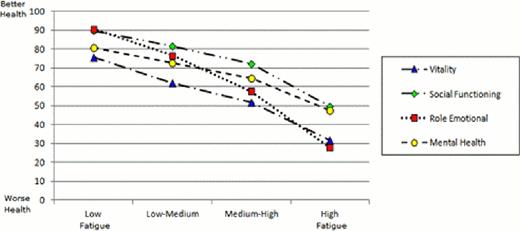Abstract
Abstract 4234
Whilst recent data indicates that survival of chronic myeloid leukemia (CML) patients, who are in complete cytogenetic response (CCyR) with Imatinib therapy, is not statistically significantly different from that of the general population, health-related quality of life (HRQOL) differences do exist. However, to date no study has investigated the predictive factors of long-term HRQOL outcomes of CML patients treated with TKIs.
The main objective of this study was to investigate potential key factors associated with long-term HRQOL outcomes of CML patients in CCyR treated with first line Imatinib therapy. A secondary objective was to investigate the relationships between fatigue and other treatment related symptoms and describe how fatigue relates to socio-demographic and clinical data.
Analysis was performed on 422 CML patients recruited in an observational multicenter study. Median time in treatment with Imatinib was five years (range: 3 to 9.3 years). HRQOL was assessed with the Medical Outcomes Study 36-Item Short-Form Health Survey (SF-36). This questionnaire consists of 36 items covering eight generic HRQOL domains: physical functioning (PF), role limitations due to physical health (RP), bodily pain (BP), general health perceptions (GH), vitality (VT), social functioning (SF), role limitations due to emotional problems (RE), and mental health (MH). Predictor variables investigated included, fatigue and social support, measured with two psychometrically robust questionnaires, that is the Functional Assessment of Chronic Illness Therapy (FACIT)-Fatigue scale and the multidimensional scale of perceived social support (MSPSS) scale. Other CML treatment related symptoms were measures with an ad hoc CML symptom checklist. Key socio-demographic and clinical data including, age, gender, education, Sokal risk, response to therapy and duration of treatment, were also considered. Univariate and multivariate regression analyses were used to identify a set of independent predictors for each SF-36 scale, via a stepwise selection procedure.
In the multivariate analysis the following factors independently predicted a better PF: younger age (P<0.001), being male (P<0.001), higher education (P=0.002), and less fatigue(P<0.001). Together, this set of variables explained 56% of the variance in the PF scale. Fatigue was the only variable showing an independent and consistent association across all HRQOL domains measured by the SF-36. Role physical (RP) and role emotional (RE) scales (SF-36) were found to be the two mostly compromised aspects by fatigue severity. As fatigue was found to be the main predictor variable, for descriptive purposes in figure 1 we report mean scores of the SF-36 scales by levels of fatigue. Mean score differences, between patients reporting low versus high fatigue levels, were respectively 70 and 63 points for the RP and RE scales. Higher perceived social support independently predicted better social functioning (P<.001) and mental health (P<.001). Hb levels, measured at the most recent follow-up visit (mean time 2.9 weeks), showed a weak correlation (r=.187) with fatigue. Higher levels of fatigue were more common in those patients who already had comorbidity at diagnosis and in female patients. Patients who reported higher levels of fatigue also reported a higher severity of other CML symptoms.
To our knowledge, this was the first investigation to date of factors associated with long-term HRQOL in CML patients being treated with an oral anticancer-targeted therapy. Our findings suggest that although responding to Imatinib therapy, long-term patient's HRQOL is greatly affected by fatigue levels. Also, our results suggest that symptom management is crucial to the possible improvement of HRQOL outcomes.
Health-related Quality of Life aspects by Fatigue severity.
a) Physical health-related aspects
Health-related Quality of Life aspects by Fatigue severity.
a) Physical health-related aspects
b) Mental health-related aspects
Low, Low-Medium, Medium-High and High correspond respectively to the 4th (75th to 100th percentile), 3rd, 2nd and 1st (0th to 25th percentile) quartile of FACIT-Fatigue scale. On this scale, the higher the score the lower is the level of fatigue.
Efficace:Bristol Myers Squibb: Consultancy; Novartis: Research Funding. Baccarani:Novartis : Consultancy, Honoraria; Bristol Myers Squibb: Consultancy, Honoraria; Pfizer and Ariad: Honoraria. Breccia:Bristol Myers Squibb: Consultancy; Novartis: Consultancy. Rosti:Novartis: Consultancy, Honoraria, Research Funding; Bristol Myers Squibb: Consultancy, Honoraria. Alimena:Novartis: Honoraria; Bristol Myers Squibb: Honoraria. Turri:Novartis: Consultancy, Novartis Other; Bristol Myers Squibb: Bristol Myers Squibb, Bristol Myers Squibb Other, Consultancy.
Author notes
Asterisk with author names denotes non-ASH members.



This feature is available to Subscribers Only
Sign In or Create an Account Close Modal